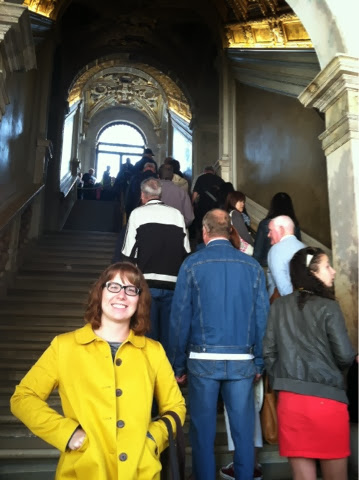Right now, we're leaving the center of Rome and we're on our way to Pompeii. It's a three hour bus drive, and I hope to use this time to catch up on my writing. For the last two days, we've explored the city of Rome. We first visited the Colosseum, a massive structure located in a part of the city called the Forum. The Forum is the most historical part of Rome where many of the great monuments have been excavated and are now protected by a pricey entrance fee. I was surprised to learn that many Romans don't the Forum because the cost to get in is too expensive.
Anyways, the main attraction of the forum is obviously the colosseum. I knew it was huge, but I gained a whole new appreciation for it's size when I saw it in person. It looks as big as Lucas Oil Stadium (I don't know the actual size), and it was built well over 1,000 years ago! I learned that it only took 8 years to complete. Remember when I wrote that the Duomo took over 100 years to build? Yeah, the colosseum dwarfs the size of the Duomo.
These people are taking a special archeological tour on the floor of the colosseum. They reconstructed the floor partially so we can see what it would have looked like when gladiators performed. Under the floor, you can see a maze of walls and chambers. This is where wild animals like lions and tigers would be stored. Elevators using a pulley system (Romans invented pulleys) would bring the animals up to the arena through trap doors. Gladiators or unfortunate prisoners would be already on the floor of the arena either to fight them or wait to be eaten by them.
The colosseum was built for games. It was free for the public to attend the games no matter their social status. Games also changed. Apparently, there were 3 or so different varieties. One was the gladiator fights. Contrary to what I thought happened, gladiators were actually professional fighters and the people they fought (and usually killed) were prisoners of war, criminals, or disobedient slaves dressed like gladiators. Gladiators were expensive to have around, and were treated like celebrities. Women would even collect their sweat after a show, and use it as perfume.
Another game was gladiators vs. wild animals. Gladiators would battle with multiple lions, tigers, or bears (oh my!). The poor animals were imported from Africa or other distant countries and then starved before a fight to ensure that they were extra angry.
The last (and most popular) game was theatrical public execution. If you committed a crime or were a prisoner of war, they'd stage battles or scenes from plays or historical events in which people were killed. You'd be brought to the arena, dressed in costume, and would quickly (or slowly) be executed. You might also simply be fed to one of the wild animals while thousands of people watched (50,000-80,000 people to be exact)
Sometimes prisoners would survive the fights. If that happened, they were granted their freedom and would walk out if the colosseum through the "Alive Door".
The colosseum itself was built by professional slaves. I learned that professional slaves were people owned by the wealthy, experts in specific trades, and treated very well. You'd only be punished if you betrayed your owner or committed a crime.
20 professional salves would be in charge of each section of archway. Each group of slaves would work in unison so that when a work day was finished, it looked exactly the same the entire way around the colosseum. This explains why it was finished after only 8 years.
After the colosseum, we walked through the rest of the forum. Here are some of the sights....
The Temple of Vesta. This place has an interesting story. Special women were selected from a very young age to live in this temple as a virgin until they turned 30. Men were forbidden to even touch it's steps. If they did, they were executed. The founders of Rome, Romulus and Remus, were allegedly conceived miraculously to one of these virgins. When it was discovered that she was pregnant, she was punished by being buried alive after giving birth to twins. The twins survived because a soldier could not bring himself to kill them. Instead, he left them in the wild. The babies were then discovered by a mother wolf, and she adopted them as her own. To this day, the symbol of Rome is a she wolf to honor the mother of Rome's creators.
An ancient condo. This is like an apartment building. This picture shows the actual level of Ancient Rome. It sat 25 feet below modern day Rome.
Ciao!





















































